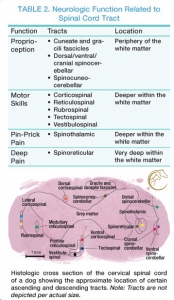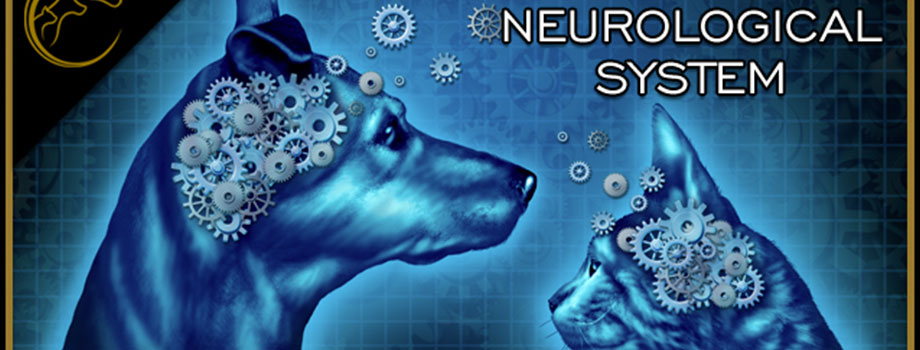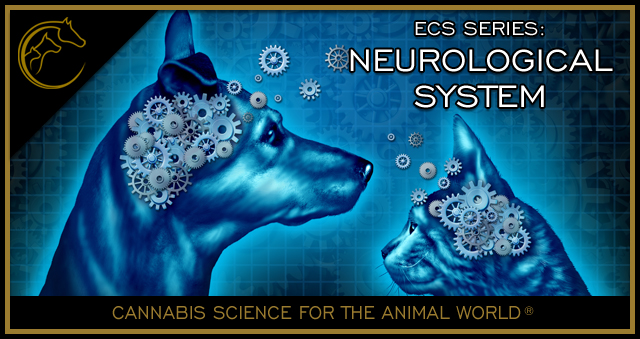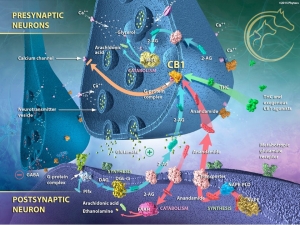ECS Series: Neurological System
When CBD first became the buzz word, many had never heard of an endocannabinoid system (ECS), let alone how important it is for the normal development of the nervous system. And while the medical community has learned volumes regarding exactly how the ECS interacts with and modulates neurological tissues, passing that complex information to pet parents … well, it’s left folks scratching their heads. Today we’re going to simplify things so you have an understanding of just how important a healthy endocannabinoid system is to the well-being of your pet’s nervous system.
Let’s start with what makes up a nervous system in cats and dogs. Hint: it’s the same cells, tissues, and organs which make up the nervous system in humans … just like the ECS. The nervous system is made up of two main parts based on location: central and peripheral. The central nervous system (CNS) consists of the brain and spinal cord, while the peripheral nervous system (PNS) encompasses all other parts of the body.

Central Nervous System
The brain has three main sections, each with its own special functions but not isolated from others. Cerebral tissues govern conscious decisions; the brainstem hosts nerve centers which oversee most of the critical life functions; and cerebellar input controls movement and balance.
Within the cerebrum, nerve cells (neurons) transmit information via action potentials – electrical impulses which must meet a certain milli voltage threshold before messages jump to the next cell. Signalling for action potentials, whether initiation or cessation, is performed by neurotransmitters like endocannabinoids. If too low, no information is passed at all or is rerouted to nearby neurons which are capable of continuing the action potential. This happens all the time as part normal neurological functions. It can also occur after traumatic injuries, stroke, and other serious neurological imbalances. Sometimes those same imbalances can cause an action potential to be too high or continue too long, contributing to imbalances like seizures, insomnia and anxiety (runaway thoughts especially).
The brainstem controls the flow of messages between the brain and the rest of the body. Bodily functions like breathing, swallowing, heart rate, blood pressure, and whether one is awake or sleepy. No, cats do not have a more developed brainstem which tells them to sleep 24/7; that’s their prey drive telling them to save as much energy as possible. When hunting, cats usually miss their targeted meal 7/10 times … that’s a lot of energy use and sleeping helps their body remain ever ready for an opportunistic chance to pounce. When balanced, the brainstem functions normally in the background, a part of the autonomic nervous system (ANS). Thankfully, imbalances are not common as they are often life-threatening.
Cerebellar functions are markedly pronounced in cats when compared to dogs and humans. This is why they often land easily on their feet after catching birds, an adaptation that increases their chance of survival both from a meal perspective and in escaping injuries. It’s not foolproof and gravity affects us all when 10 stories high, so consider screening in balconies for safe outside time. When balanced, the cerebellum allows dogs and cats to navigate the world with more agility and us mere humans. When unbalanced, conditions like cerebellar hypoplasia occur, a congenital malformation in kittens whose mothers contracted certain viruses while pregnant. Despite the condition being permanent, CH cats often have very healthy long lives … and are adorable in their awkward playing.

Spinal cord functions can best be described as a multilevel highway whereby certain information is transmitted in different anatomical locations. Like the brain, the spinal cord contains both white & gray matter, though the white matter of spinal cords is peripheral, whereas the brain’s white matter is centrally located. This makes sense when we consider white matter contains relatively few cell bodies and is composed mostly of long-range myelinated axons, a type of neuron which can speed electrical information across relatively long distances.
In the spinal cord, peripheral white matter neurons are responsible for proprioception, the ability for dogs and cats to place their feet without conscious thought. Try this: with your dog standing quietly on solid ground, gently lift a front paw and place it furred sided down. Your dog will immediately turn it over so that his pads are ground-facing. A little deeper into the spinal cord’s white matter we find motor skill neuronal transmission. Simply put, information on this level allows your cat to make those amazing leaps straight up to catch birds, bugs and feather toys. The next level allows the body to recognize and respond to mild sensory stimuli, allowing dogs and cats to avoid thorny ground and similar pinprick like sensations.The deepest layer of spinal cord white matter transmits deep pain, that which really hurts, like traumatic injuries or severe soft tissue damage. Centrally located, spinal cord gray matter is the workhorse, transmitting all kinds of data between the body and brain.

Peripheral Nervous System
Neurons found within the PNS transmit both sensory and motor input, much like neurons do in the CNS. In this case, motor information directs muscle movement in tissues like the heart, intestines and skeletal muscles. Sensory input helps determine things like when to stop eating (stretch receptors in the stomach), when to use the litter box (stretch receptors within the bladder), and when to roll over during solar charging (temperature sensors within the skin). While it’s the CNS which tells the body to perform these tasks, it is the PNS which informs the brain of the stimuli, and the spinal cord which carries the information. The PNS is highly flexible and imbalance in any one area can often be compensated for elsewhere. For example, if your dog sustained an injury which severed a peripheral nerve in his paw, he may have areas of insensitivity … but nearby sensory and motor nerves are likely to take over allowing for a normal gait.
Endocannabinoid-Neurological System
No, there’s not actually a system named that but the integration is so deep that it might as well be called such. Endocannabinoids and their plant-based counterparts (phytocannabinoids) like CBD, function as neurotransmitters, neuromodulators, and immunomodulators. In addition, the entire ECS integrates with a variety of other receptor systems, modulating their functions in order to maintain healthful homeostasis. Other neurotransmitters like serotonin, dopamine, glutamate & gamma-aminobutyric acid (GABA) are directly or indirectly modulated by the ECS. While this process is complex, the effects can be simplistic and drastic.
Via influx of compounds like CBD & THC, cannabis receptors are able to calm action potentials attributed to imbalances within any tissue containing neurons. In other words, all tissues within the body are modulated by the ECS. This means a healthy, well-supported ECS is able to quickly cause peripheral vasodilation, bronchodilation and release of compounds which are soothing, all during times of anxiety. In addition, balanced cannabis receptors are vital in helping the brain’s action potentials remain healthy, working with the body when action potentials become too great. In order to help them remain balanced, supplementation with ratioed hemp supplementation is important as CBD only products only address a part of the complex system.
I know we’ve covered a lot today, but I hope you are left with a better understanding of the nervous system and how the ECS supports its normal functions. Furthermore, providing the ECS with balanced compounds it can use wherever chemical messengers signal, can help your pet remain in top shape for years to come. We’ll see you next time when we discuss the ECS and behavioral responses.







